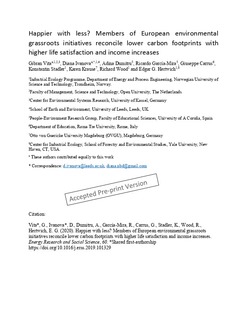| dc.contributor.author | Vita, Gibran | |
| dc.contributor.author | Ivanova, Diana | |
| dc.contributor.author | Dumitru, Adina | |
| dc.contributor.author | García-Mira, Ricardo | |
| dc.contributor.author | Carrus, Giuseppe | |
| dc.contributor.author | Stadler, Konstantin | |
| dc.contributor.author | Krause, Karen | |
| dc.contributor.author | Wood, Richard | |
| dc.contributor.author | Hertwich, Edgar G. | |
| dc.date.accessioned | 2019-11-22T10:26:08Z | |
| dc.date.available | 2019-11-22T10:26:08Z | |
| dc.date.created | 2019-11-20T16:05:21Z | |
| dc.date.issued | 2020 | |
| dc.identifier.issn | 2214-6296 | |
| dc.identifier.uri | http://hdl.handle.net/11250/2630041 | |
| dc.description.abstract | Scientists and policymakers recognize the need to address consumption and lifestyles in order to reconcile environmental and development agendas. Sustainability-oriented grassroots initiatives emerge bottom-up to create opportunities for sustainable lifestyles; yet no prior assessment has ascertained the efficacy of their members to reduce carbon footprints (CF) and enhance well-being. We compare the CF of non-members and members of grassroots initiatives in the domains of food, clothing, housing and transport. We further compare the groups by testing the influence of socio-economic variables that are typically associated with both footprint and well-being. Here we show that grassroots initiative members have 16% lower total carbon footprint, and 43% and 86% lower carbon footprints for food and clothing respectively, compared to their “non-member” regional socio-demographic counterparts. We find a higher adoption of some energy-saving behaviors for initiative members such as greater active travel distance and lower indoor temperatures in the winter, yet no significant differences in the CF of housing and transport. Interestingly, increases in income are not associated with increases in the total CF of members, while the influence of income is confirmed for the CF of the total sample. Instead, factors such as age, household size, and gender better explain the variation in the domain-specific CFs of initiative members. Finally, members show higher life satisfaction compared to non-members and are 11–13% more likely to evaluate their life positively. Our results suggest that initiative members uncover lifestyle features that not only enable lower emissions, but also reconcile emissions with income and well-being. | nb_NO |
| dc.language.iso | eng | nb_NO |
| dc.publisher | Elsevier | nb_NO |
| dc.rights | Attribution-NonCommercial-NoDerivatives 4.0 Internasjonal | * |
| dc.rights.uri | http://creativecommons.org/licenses/by-nc-nd/4.0/deed.no | * |
| dc.title | Happier with less? Members of European environmental grassroots initiatives reconcile lower carbon footprints with higher life satisfaction and income increases | nb_NO |
| dc.type | Journal article | nb_NO |
| dc.type | Peer reviewed | nb_NO |
| dc.description.version | acceptedVersion | nb_NO |
| dc.source.volume | 60 | nb_NO |
| dc.source.journal | Energy Research & Social Science | nb_NO |
| dc.identifier.doi | 10.1016/j.erss.2019.101329 | |
| dc.identifier.cristin | 1750073 | |
| dc.description.localcode | © 2019. This is the authors’ accepted and refereed manuscript to the article. Locked until 6.11.2021 due to copyright restrictions. This manuscript version is made available under the CC-BY-NC-ND 4.0 license http://creativecommons.org/licenses/by-nc-nd/4.0/ | nb_NO |
| cristin.unitcode | 194,64,25,0 | |
| cristin.unitname | Institutt for energi- og prosessteknikk | |
| cristin.ispublished | true | |
| cristin.fulltext | postprint | |
| cristin.qualitycode | 1 | |

